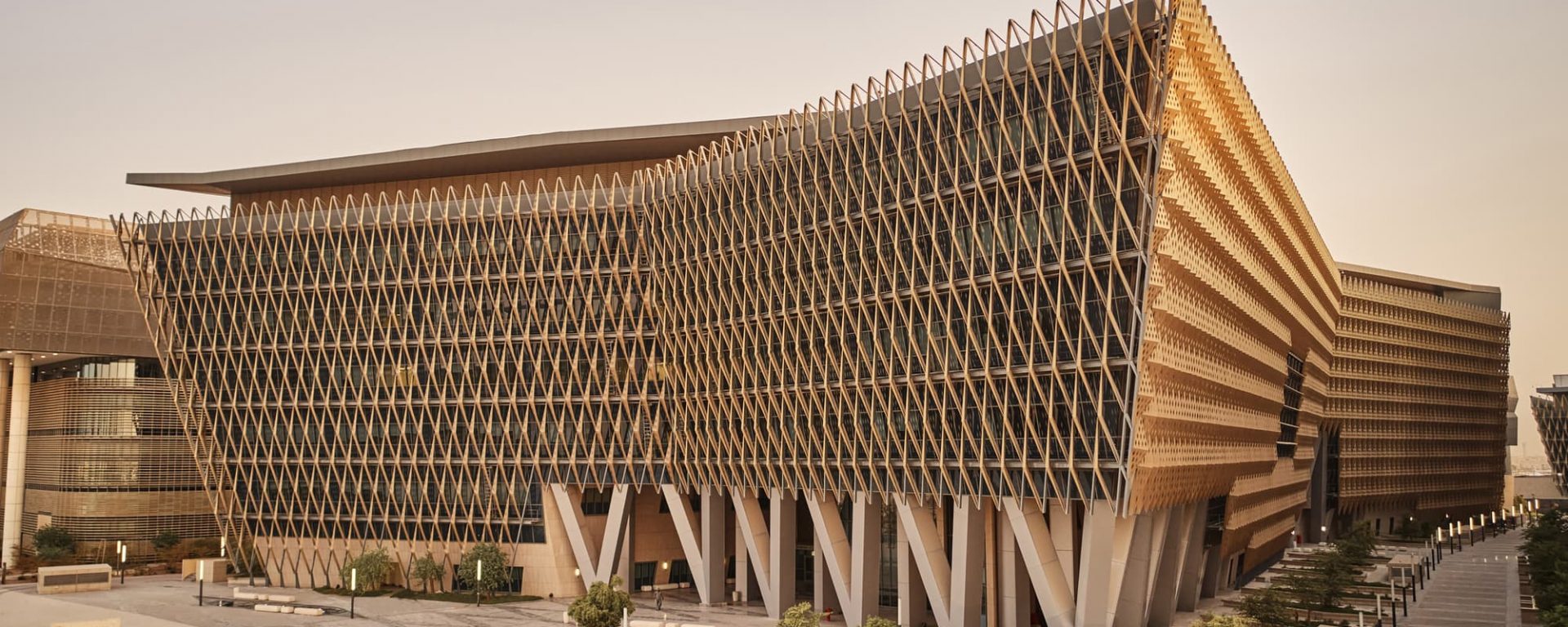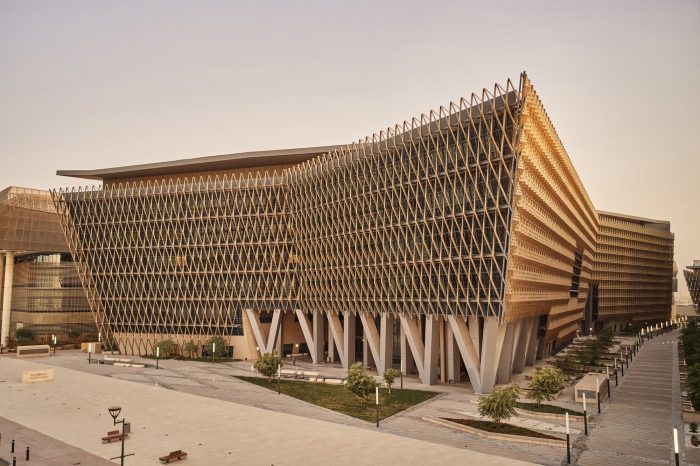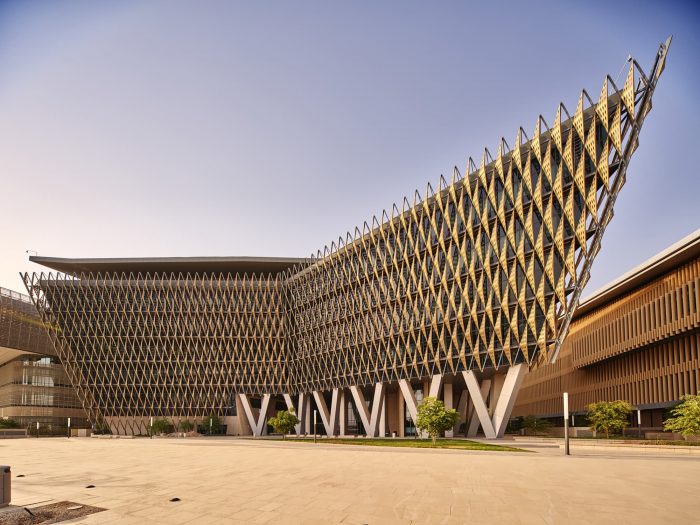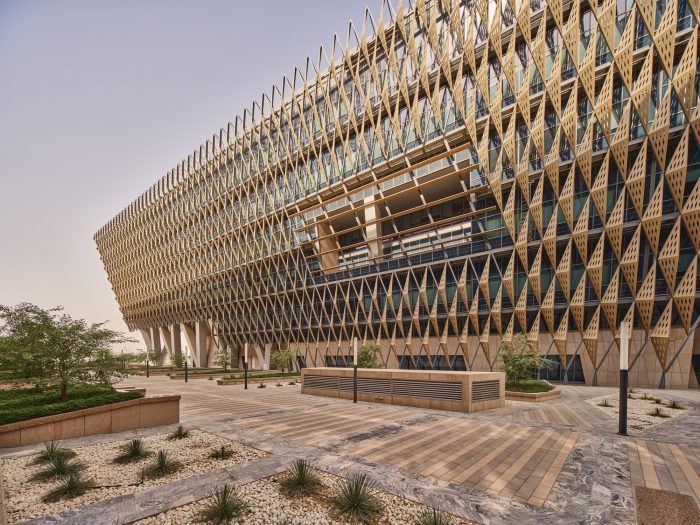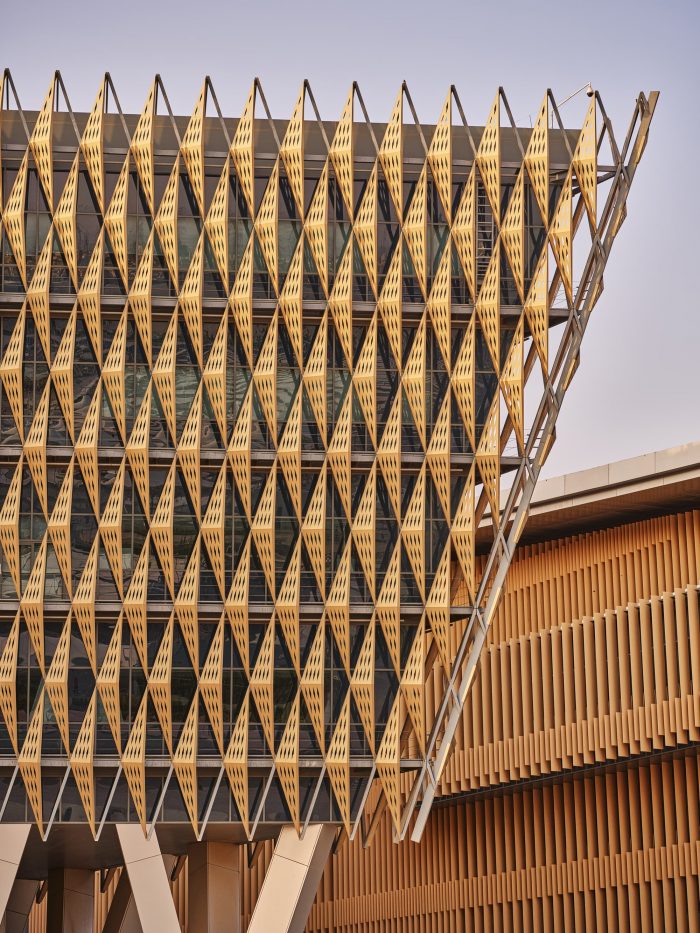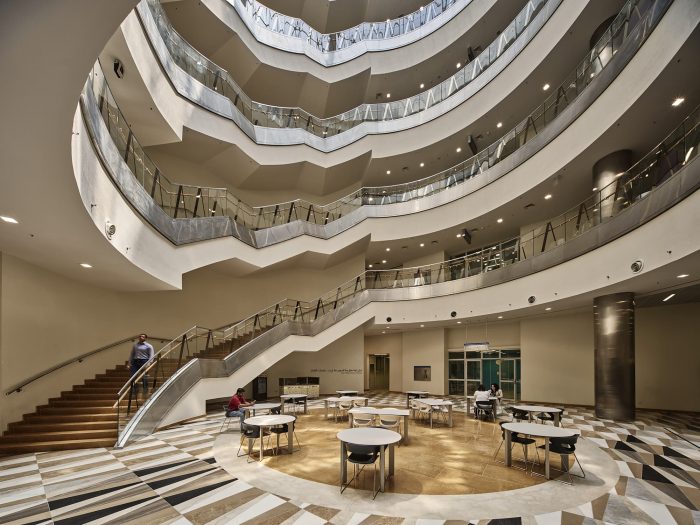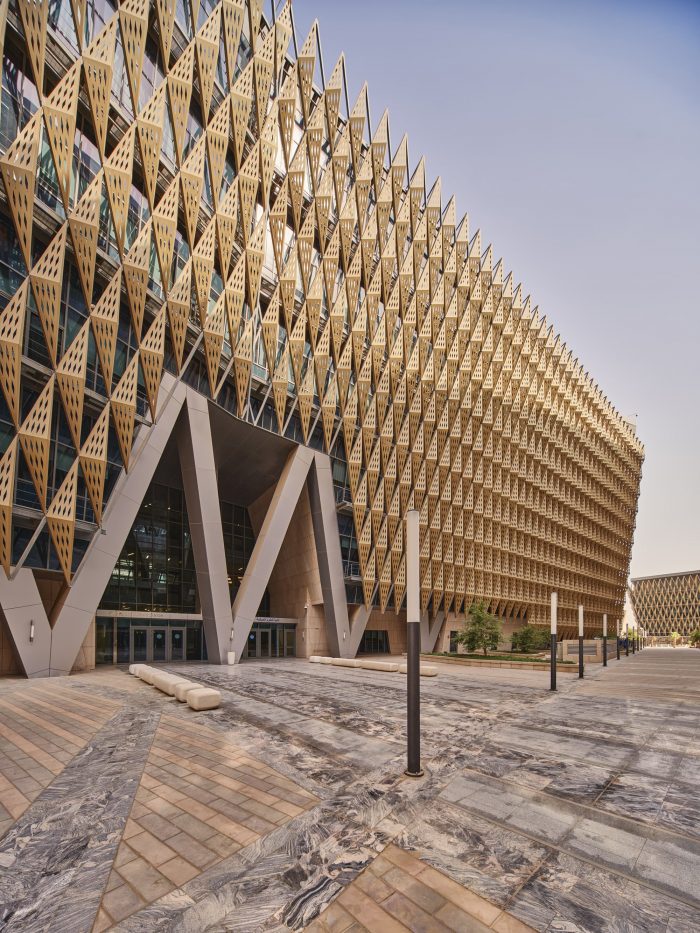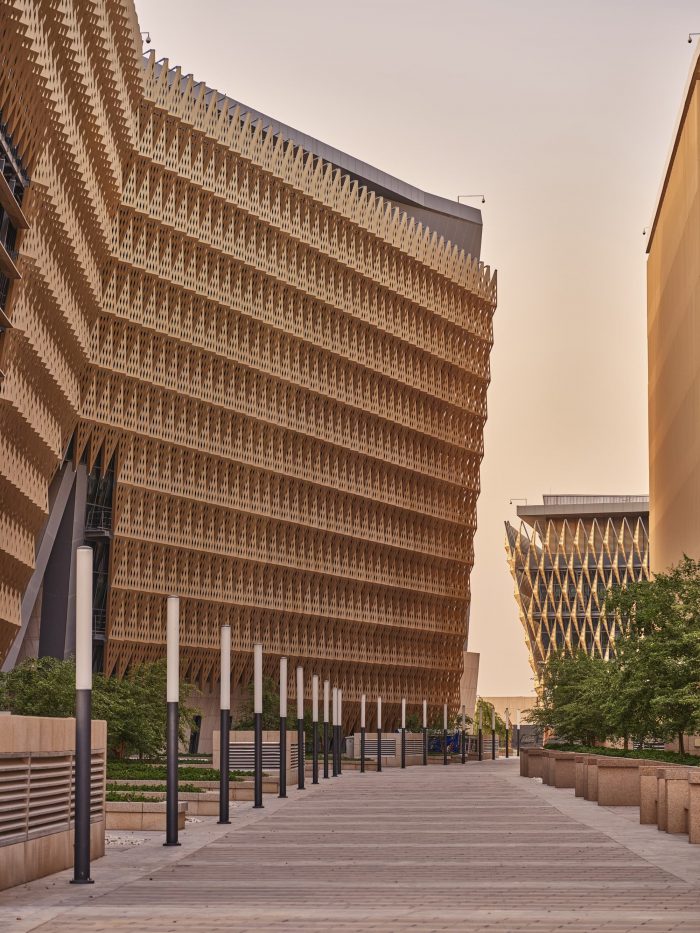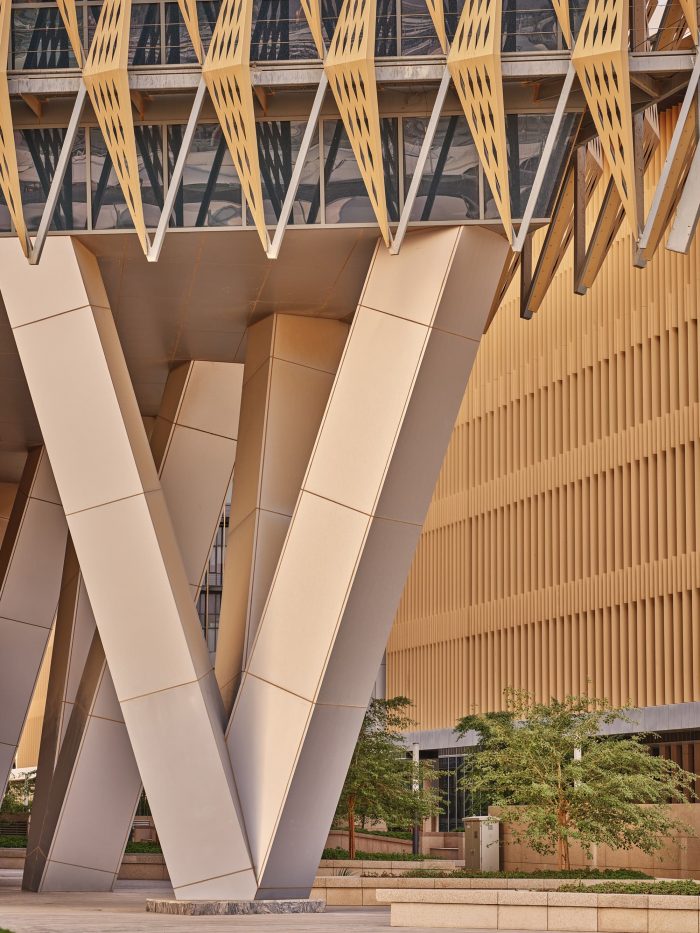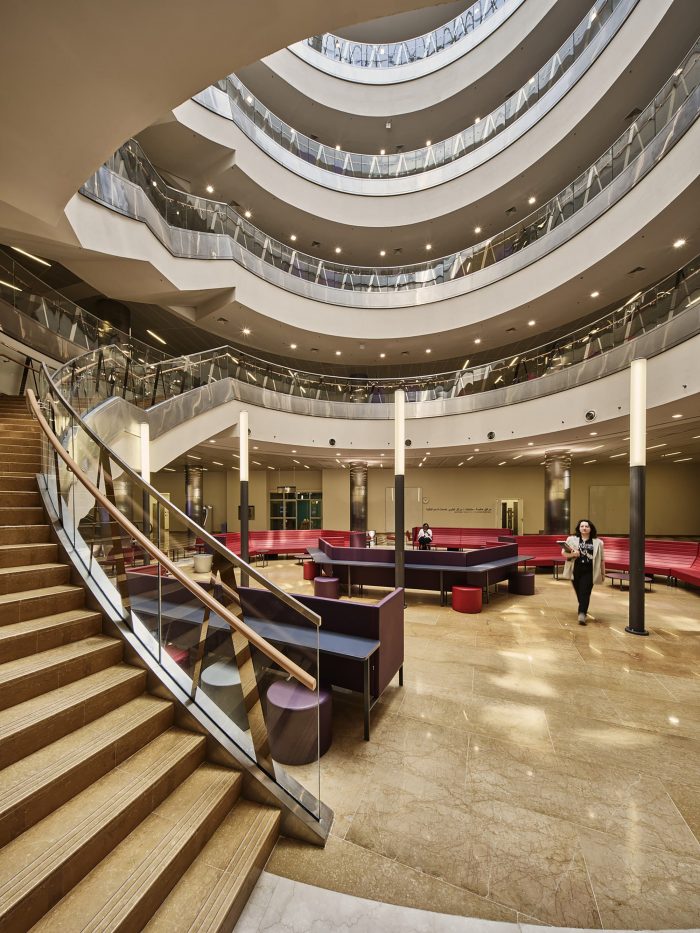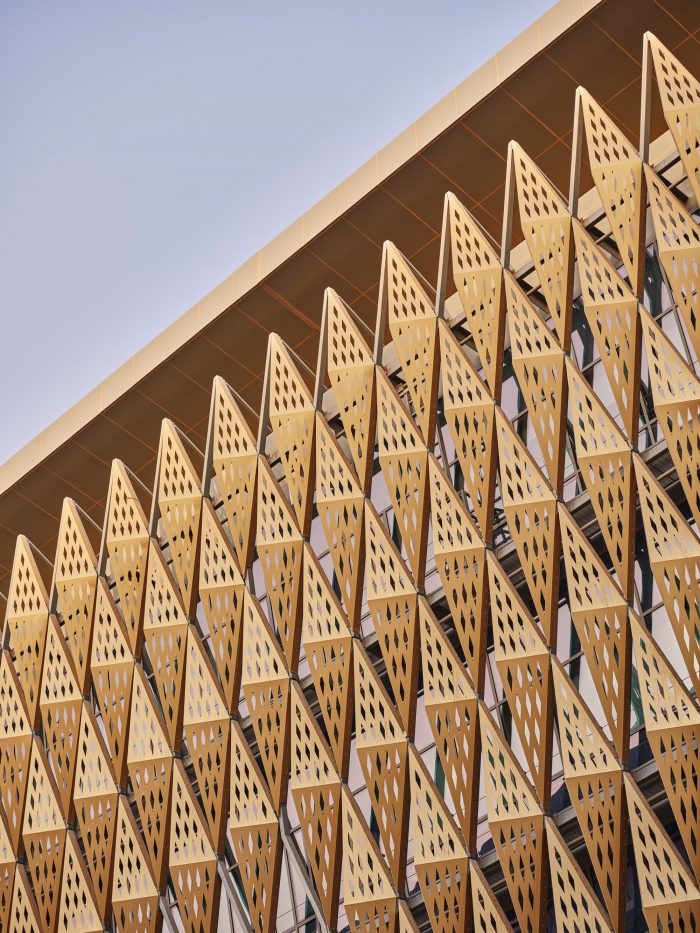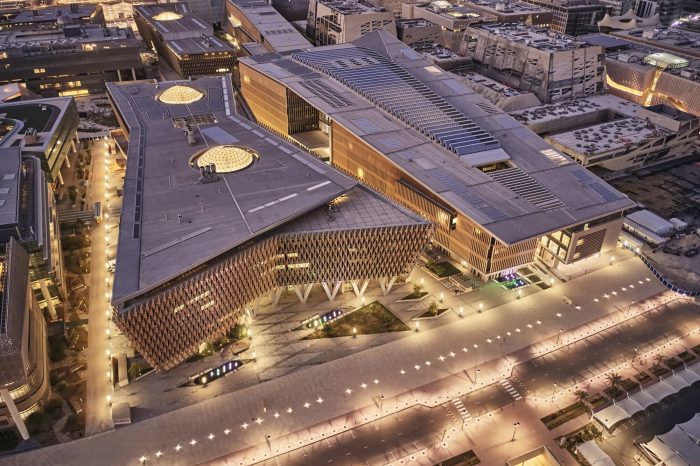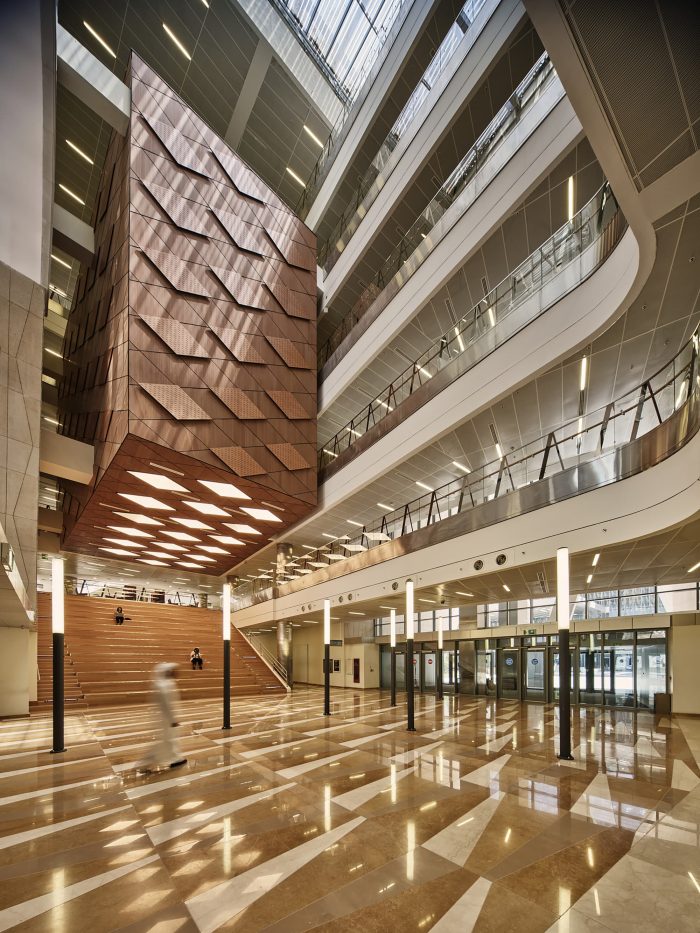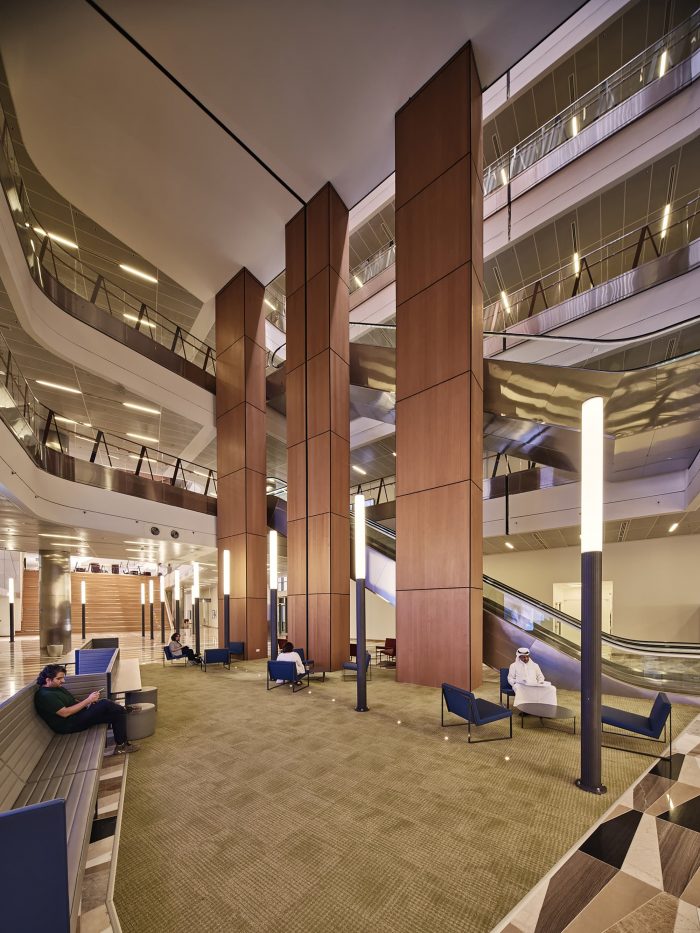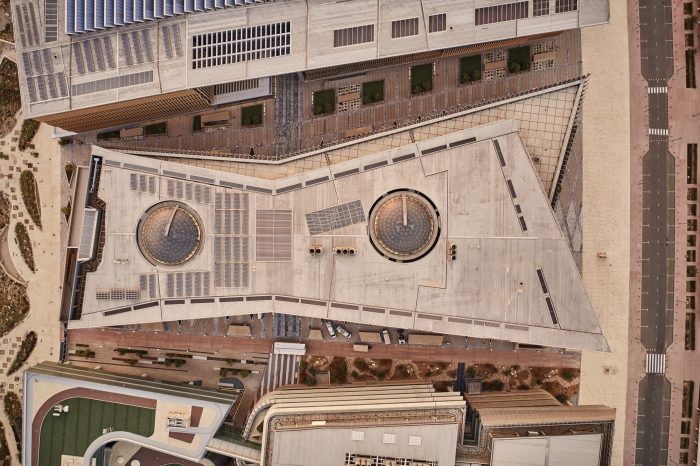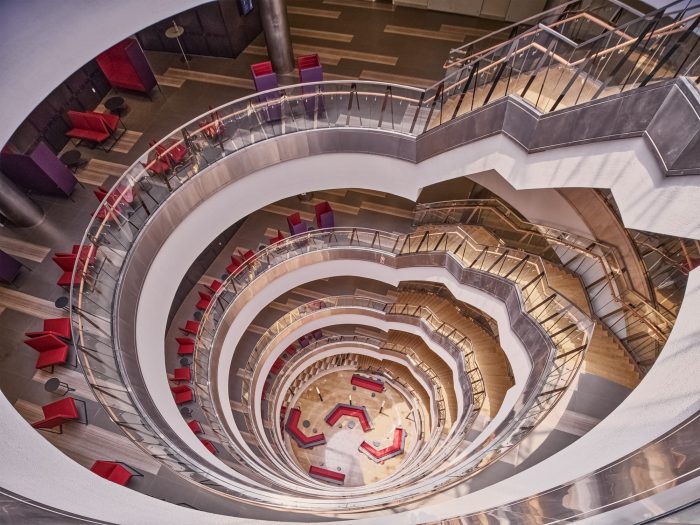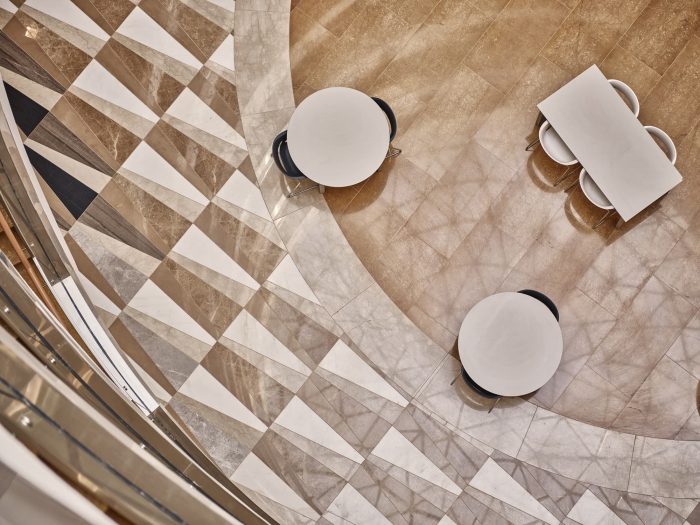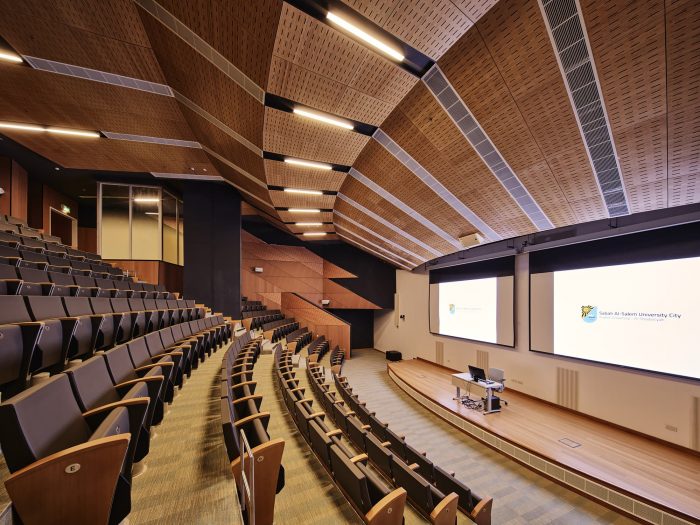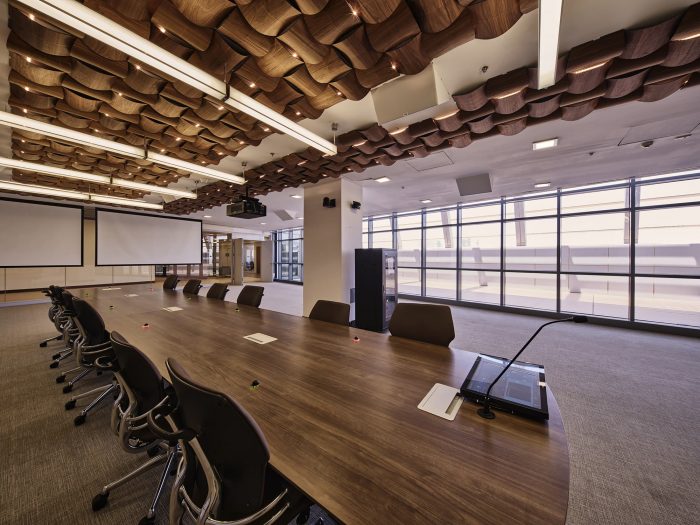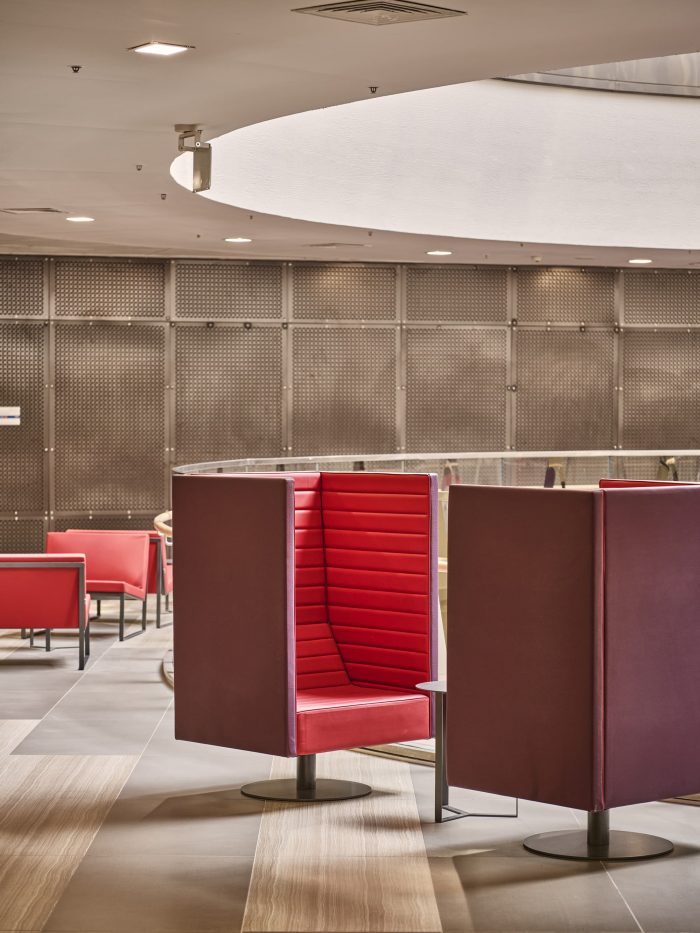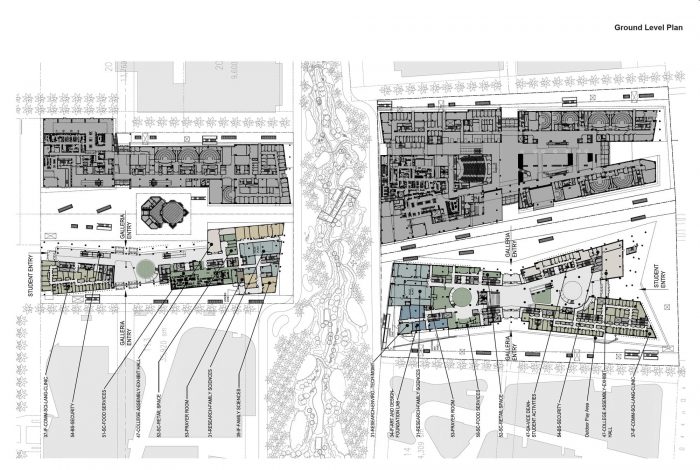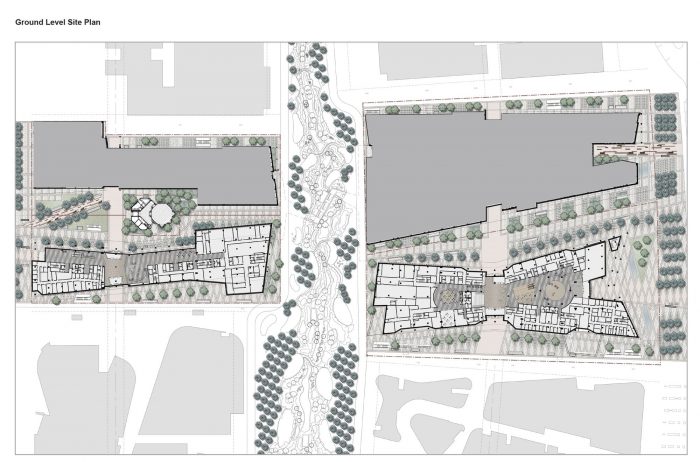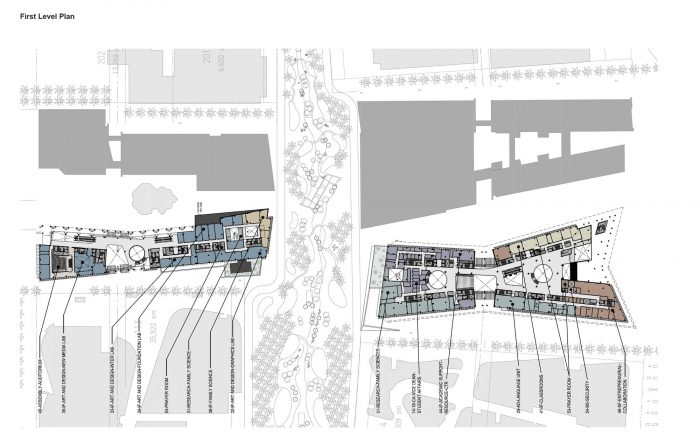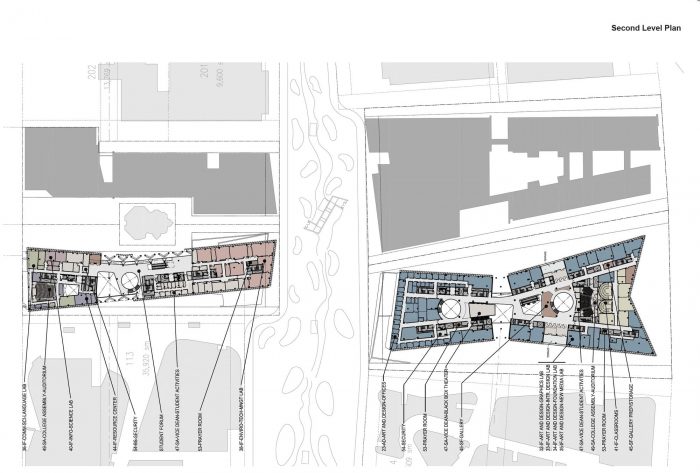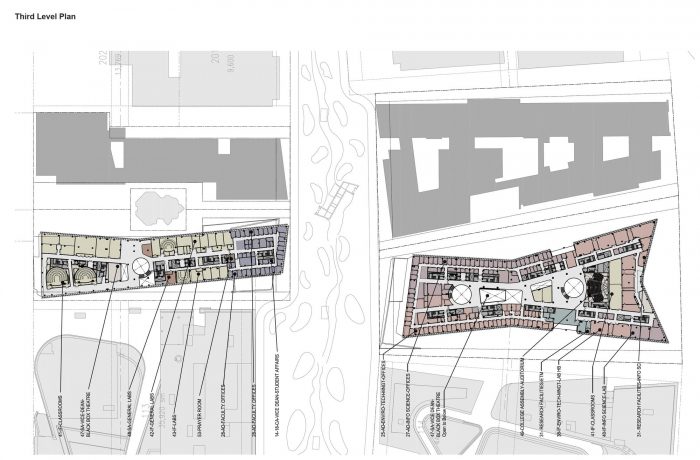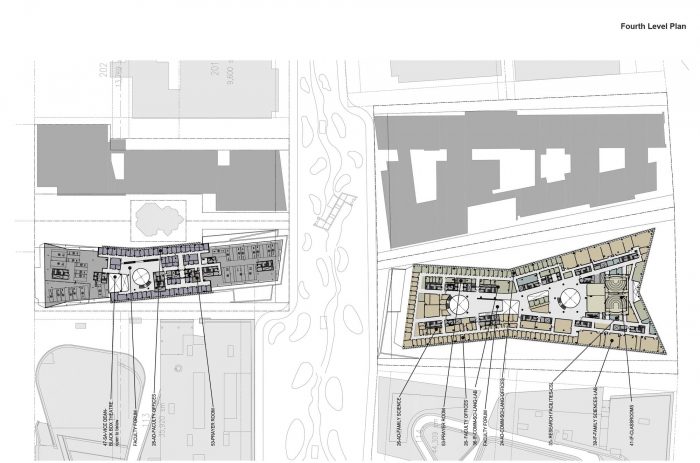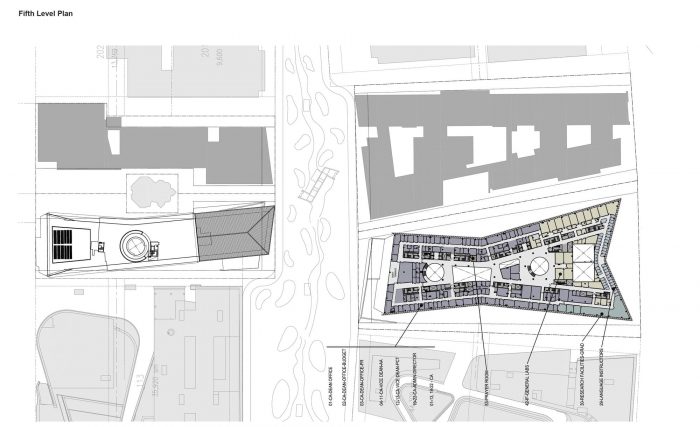生命科学学院是一个优雅的例子,它结合了项目要求和对特定场地和环境条件的反应,创造了一个独特的、完全适合研究艺术和环境的学院。这座对场地反应特别强烈的建筑,以其引人注目的、有棱有角的倾斜外墙和引人注目的、沙漠色的、有纹理的材料包层而闻名。菱形结构的阵列–穿孔金属板–过滤了自然光,并为室内遮挡了刺眼的阳光。金色结构的颜色强度随着一天中太阳的移动而变化,就像周围的沙漠一样。面板阵列的棱角几何形状与建筑占地面积和周围景观特征相呼应。
The College of Life Sciences is a graceful example of a building that combines programmatic requirements and response to a specific site and environmental conditions to create a unique and wholly appropriate college for the study of art and the environment. This exceptionally site-responsive building is notable for its dramatic, angular sloped façade and its cladding of striking, desert-colored, textured material. The array of diamond-shaped forms—perforated metal panels—filter natural daylight and shade the interior from the harsh sun. The color intensity of the golden structure changes with the sun’s movement throughout the day, much like the surrounding desert. The angular geometry of the panel array is echoed in the building footprint and surrounding landscape features.
外墙在上升过程中向外倾斜,创造了一个自我遮阳的情况,允许向外看,而没有不必要的热量渗入内部的风险。这进一步得到了由穿孔金属板组成的屏幕遮阳系统的支持,该系统可以将视野引向外面,并减轻太阳的眩光。百叶窗被安置在每个建筑的表面,以管理来自每个罗盘点的光线,因此,例如北面允许充足的光线进入,因为这种间接光线对艺术工作室来说是最佳的。
Exterior walls slope out as they rise, creating a self-shading situation that allows views to the outside without risking unnecessary heat penetrating inside. This is further supported by a screen shading system of perforated metal panels that direct views out and mitigate solar glare. Louvers are positioned on each building’s face to manage light from each compass point, so that north, for example, allows ample light in because this indirect light is optimal for art studios.
南面和西面的百叶窗系统比较严密,在保持室内舒适度的同时,仍然可以看到外面的景色。在内部,COLS是围绕着充满活力的多层中庭组织的,其中一个中庭专注于学生服务,包括一个美食广场和非正式会议区,另一个则更多地面向公众,在演示实验室和实习诊所中可以看到学生工作的多样性。它们为COLS的所有活动提供了窗口,促进了学生/教师的互动。每个中庭的周边都有一个缓缓倾斜的螺旋形楼梯,提供通往各层的通道,最后是一个圆顶天窗形式的椭圆。促进学生合作、非正式学习、社会联系,以及对内部工作的庆祝,是学院围绕两个实质性中庭组织的指导原则。
The South and west sides have a tighter louver system to still allow views out while keeping the interior comfortable for occupants. Internally, COLS is organized around vibrant, multi-level atria—one of which is focused on student services and includes a food court and informal meeting areas and the other more public-facing, with the diversity of student work visible in demonstration labs and practicum clinics. They provide windows into all COLS activities and foster student/faculty interaction. Each atrium perimeter is a gently sloping spiral stair providing access to all levels, culminating in an oculus in the form of a domed skylight. Fostering student collaboration, informal learning, social connection, and a celebration of the work within were the guiding principles behind the organization of the college around the two substantial atria.
开放教室、实验室和工作室的视觉通道,强调了学生工作的重要性以及发现和创造的活力。同样,围绕着学生餐厅和其他非学术性服务的中庭的设计和布置也是为了支持学生的工作和放松方式。在整个建筑中,休闲座椅、支持基于项目的合作的技术,以及一个论坛式的分层座位区,都鼓励学生停下来分享想法,与朋友叙旧,并在课间共享美食时放松。
Opening visual access to classrooms, labs, and studios underscores both the importance of student work and the vibrancy of discovery and creation. Similarly, the atrium around which student dining and other non-academic services are organized is designed and furnished to support the way students work and relax. Throughout the building, casual seating, technology to support project-based collaboration, and a forum-like tiered seating area encourage students to stop and share ideas, catch up with friends and relax over a shared meal between classes.
学院的流通是沿着两个南北平行的侧翼组织的,侧翼位于中庭。这些流通路径是学院的知识和教学核心,与贯穿校园、连接各学院的东西向长廊相交。这些交汇点构成了COLS内部身份的枢纽。学生生活活动围绕这些节点进行,包括餐饮服务、零售、学生俱乐部、休息室、展览厅和大型讲座设施。
Circulation in the college is organized along two north-south parallel wings that flank the atria. These circulation paths, the college’s intellectual and pedagogical core, intersect the east-west Gallerias that run across the campus linking each college. These intersections form the nexus of COLS’s internal identity. Student life activities are grouped around these nodes, including food service, retail, student clubs, lounges, exhibit halls, and large lecture facilities.
一个慷慨的、明确的入口从学生到达区将学生和访客直接带入主中庭,在那里一个开放的、阶梯式的论坛鼓励学生进行非正式的互动。潜在的主题,即建筑的创新特征的核心,是可见性的概念。从学生们在中庭的相互对视,到繁忙的实验室和教室的景观,到向那些在校园内一分为二的加仑街上经过的人展示生命科学学院的工作,再到向绿洲和整个校园的宽阔视野,生命科学学院在其设计的每一个方面都努力追求可见性。
A generous, well-defined entrance from the Student Arrival Zone brings students and visitors directly into the primary atrium where an open, stepped forum encourages informal student interaction. The underlying theme, the core of the building’s innovative character, is the concept of visibility. From students seeing one another in the atria to views of busy labs and classrooms to showing off the work of COLS to those passing through on the campus-wide galleria street that bisects the building, to generous views out to the oasis and the overall campus, the College of Life Sciences strives for visibility in every aspect of its design.
Architects: CambridgeSeven, Gulf Consult
Area : 74322 m²
Year : 2020
Photographs :Mohammad Taqi
Manufacturers : Clestra Hauserman, Pentair, Armstrong, Bega Germany, Crane Pumps & Systems – USA, Deutschtec Germany, Dorma, EBARA Japan, Ebara Italy, Froch Enterprises Taiwan, Inds Metal Center, International Environmental – USA, MIRCOM TECHNOLOGIES, Mechline, Milliken / Constantine, Mobatime Switzerland, OtisSamsung
General Contractor : SINOHYDRO Corp. Ltd., Al-Hani Construction and Trading Co.
Lighting Designer : Quentin Thomas Associates
Design Principal : Marc Rogers
Project Principal : Patricia Intrieri, Najla Alghanim, Robert Bander, Hank Recor, Jay Stoughtenger
Fabricator : WUHAN LINGYUN BUILDING DECORATION ENGINEERING CO., LTD
Av Designer : Vantage Technologies
City : Ardiya
Country : Kuwait

